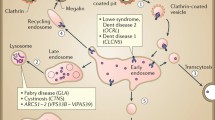Abstract
A vast array of neurotransmitters, polypeptide hormones and other extracellular signalling molecules utilize G protein-coupled pathways for transmembrane signalling. In recent years, mutations in G protein-coupled receptors and in G protein α subunits have been identified as the cause of a variety of human diseases. Both loss and gain of function mutations have been described in disorders such as Albright hereditary osteodystrophy, nephrogenic diabetes insipidus, McCune-Albright syndrome, and familial male precocious puberty. Identification of mutations in G protein-coupled receptors and in G proteins in human diseases has provided unique insights into G protein-coupled signal transduction, has important implications for diagnosis and potentially for treatment, and should stimulate the search for additional defects in G protein-coupled signal transduction in other diseases.
Similar content being viewed by others
REFERENCES
Albright F, Burnett CH, Smith PH, Parson W (1942) Pseudohypoparathyroidism: an example of "seabright-Bantam syndrome’. Endocrinology 30: 922–932.
Chakravarti A (1996) Endothelin receptor-mediated signaling in Hirschsprung disease. Hum Mol Genet 5: 303–307.
Dryja TP, Hahn LB, Reboul T, Arnaud B (1996) Missense mutation in the gene encoding the α subunit of rod transducin in the Nougaret form of congenital stationary night blindness. Nature Genet 13: 358–360.
Fujiwara TM, Morgan K, Bichet DG (1995) Molecular biology of diabetes insipidus. Annu Rev Med 46: 331–343.
Garrod AE (1923) Inborn Errors of Metabolism, 2nd edn. London: Oxford University Press.
Iismaa TP, Biden TJ, Shine J (1995) G Protein-Coupled Receptors. Austin, TX: RG Landes.
Laue L, Chan WY, Hsueh AJW, et al (1995) Genetic heterogeneity of constitutively activating mutations of the human luteinizing hormone receptor in familial male-limited precocious puberty. Proc Natl Acad Sci USA 92: 1906–1910.
Lefkowitz RJ, Cotecchia S, Samama P, Costa T (1994) Constitutive activity of receptors coupled to guanine nucleotide regulatory proteins. Trends Pharmacol Sci 14: 303–307.
Lyons J, Landis CA, Harsh G, et al (1990) Two G protein oncogenes in human endocrine tumors. Science 249: 655–659.
Moses AM, Sangani G, Miller JL (1995) Proposed cause of marked vasopressin resistance in a female with an X-linked recessive V2 receptor abnormality. J Clin Endocrinol Metab 80: 1184–1186.
Neer EJ (1995) Heterotrimeric G proteins: organizers of transmembrane signals. Cell 80: 249–257.
Parma J, Duprez L, Van Sande J, et al (1993) Somatic mutations in the thyrotropin receptor gene cause hyperfunctioning thyroid adenomas. Nature 365: 649–651.
Rudolph U, Finegold MJ, Rich SS, et al (1995) Ulcerative colitis and adenocarcinoma of the colon in Galpha-i2-deficient mice. Nature Genet 10: 143–150.
Shenker A (1995) G protein-coupled receptor structure and function: the impact of disease-causing mutations. Baillière's Clinical Endocrinology and Metabolism 9: 427–451.
Shenker A, Laue L, Kosugi S, Merendino JJ Jr, Minegishi T, Cutler GB Jr (1993a) A constitutively activating mutation of the luteinizing hormone receptor in familial male precocious puberty. Nature 365: 652–654.
Shenker A, Weinstein LS, Moran A, et al (1993b) Severe endocrine and non-endocrine manifestations of the McCune—Albright syndrome associated with activating mutations of the stimulatory G protein, Gs. J Pediatr 123: 509–518.
Spiegel AM (1995) Defects in G protein-coupled signal transduction in human disease. Annu Rev Physiol 58: 143–170.
Spiegel AM, Jones TLZ, Simonds WF, Weinstein LS (1994) G Proteins. Austin, TX: RG Landes.
Weinstein LS, Shenker A, Gejman PV, Merino MJ, Friedman E, Spiegel AM (1991) Activating mutations of the stimulatory G protein in the McCune-Albright syndrome. N Engl J Med 325: 1688–1695.
Yano K, Hidaka A, Saji M, et al (1994) A sporadic case of male-limited precocious puberty has the same constitutively activating point mutation in luteinizing hormone/choriogonadotropin receptor gene as familial cases. J Clin Endocrinol Metab 79: 1818–1823.
Author information
Authors and Affiliations
Rights and permissions
About this article
Cite this article
Spiegel, A.M. Inborn errors of signal transduction: Mutations in G proteins and G protein-coupled receptors as a cause of disease. J Inherit Metab Dis 20, 113–121 (1997). https://doi.org/10.1023/A:1005393501786
Issue Date:
DOI: https://doi.org/10.1023/A:1005393501786



